|
The MAP News
461st Edition Feb 2, 2019 |
|
FEATURE Yucatan student strives to create awareness for the preservation of the mangroves of Sisal  MEXICO - When Alexander Imanol Chan Chuc was told that his drawing could not participate in an international competition because it did not fit the horizontal format of the Children's International Mangrove Art Calendar 2019 calendar, he felt a great disappointment and a great sadness. But talent knows no barriers or obstacles, so - willing to show how he imagined an ideal natural environment in his native Sisal - Chan Chuc decided to create a new drawing, absolutely different, but of equal quality, as proof that he was chosen to illustrate to the month of February. Recently, the formal presentation of this calendar was carried out in the auditorium of the Mérida unit of the Center for Research and Advanced Studies (Cinvestav), where their respective acknowledgments were also given to both Chan Chuc and four other children whose drawings formed the images with which Yucatán participated for the first time in the contest. Children's International Mangrove organizes a drawing contest for children and adolescents each year, from which it selects 13 images that will make up the artistic calendar, which serves to raise funds and thus support various ecological causes of the world. READ MORE AFRICA The Human Element of Mangrove Management  TANZANIA - As global climate change continues to threaten coastal communities in the tropics, governments have increasingly focused on the promotion and conservation of mangrove forests for their protective qualities. Mangroves — trees and shrubs that grow in tropical estuaries — are among the world’s most productive ecosystems and, compared to other forest systems, have an impressive capacity to sequester and store carbon at high rates. They also serve as an important physical buffer, protecting coastal areas from storm surges and acting as “bioshields.” Despite these clear benefits, since 1980 the world has lost approximately 20 percent of its mangrove forests. With this in mind, there is a growing need to understand the factors, both biophysical and societal, that contribute to sustainable mangrove management. READ MORE African Coastal Forests need protection  BENIN - Over half of the tropical forests worldwide have been destroyed since the 1960s. Every second, more than one hectare of tropical forests is cut down or drastically degraded, according to the World Wide Fund for Nature (WWF), the international non-governmental organisation In Sub-Sahara Africa, Benin faces an accelerated loss of forest. According to the National Center for Remote Sensing and Ecological Monitoring (CENATEL), agricultural extension is driving the high conversion of forests and other natural ecosystems to farm land “In the space of 35 years, Benin has lost about 48 % of its dense forests,” says Luc Gnacadja, Benin’s former Minister of Environment. Not even one percent of the territory are still covered by forests The law protects various trees. They may not be cut, loped, grubbed or mutilated. These rules apply to slow-growing tree species that are needed for scientific or medicinal purposes, for example, as well as for many other classified species. “Despite these protective measures, 70 % of the people living in the rural areas cut wood for survival,” explains Romuald Djivohessou, an environment engineer and inventor based at Akpro-Missérété. READ MORE ASIA Current threats and future hopes for the greater Mekong’s mangroves  VIETNAM - While Southeast Asia is known as one of the world’s fastest-growing economic regions, home to booming metropolises like Bangkok, Ho Chi Minh City and Kuala Lumpur, it also hosts some of the planet’s most vital ecological areas. The Greater Mekong, which includes Vietnam, Laos, Cambodia, Thailand and Myanmar, is key to this environmental vitality. According to the WWF, more than 2,200 new vertebrate and vascular plant species have been discovered in the region since 1997. In the 1970s it was the most densely forested area on Earth. Since then, a third of that tree cover has been lost. Another third is expected to disappear by 2030. Urbanization, land use changes and agribusiness such as palm oil and rubber have devastated forests, along with the wildlife species which rely on them for habitat. READ MORE Group sounds alarm as industrial dumping shrinks last mangrove forest  MALAYSIA - The last mangrove swamp in Batu Maung here is now under threat of being turned into a dumpsite as tracts of the land were filled with industrial and construction waste. Sahabat Alam Malaysia (SAM) and Penang Consumers Association (CAP) said the mangrove forest was the only green lung left in Pekan Baru Batu Maung, just next to the Bayan Lepas Industrial Park. “There are only about 20ha of remaining mangrove forest here due to development in this area so it must be preserved and protected for our future generation,” said SAM and CAP research officer S. Mageswary during a site visit to the area with the media. About 15 per cent of the 20ha mangrove forest is now barren and buried under mounds of rubble, rubbish and construction waste. She said the land belonged to the federal government and was under the supervision of the Fisheries Department. “We don’t know who is dumping waste here but it is surprising that lorries can bring in waste and openly dump it on government land,” she said. READ MORE Loss of mangroves, an invite to climate catastrophes  INDIA - Tropical dry evergreen forests and the mangroves on the east coast of peninsular India have remained more accessible to humans as compared to wet evergreen forests and the mangroves on the west coast. Climate-related catastrophes like cyclone and tsunami are hitting the east coast more frequently and bringing misery to the people. Regions all along the coast, from the Sundarbans to Kanyakumari, have steadily been losing natural dry evergreen forests as well as mangrove vegetation. Communities are increasingly resorting to shrimp culture, fruit orchards, plantation crops, salt pans, etc. Even village cattle swim across creeks and graze in mangrove vegetations, especially Avicennia marina. Further,Avicennia officinalisare also found to be degrading because of high salinity. Local communities are also dependent on mangrove forests for firewood. As part of Management Effectiveness Evaluation team for studying some sanctuaries and national parks in Tamil Nadu, I along with Dr P S Easa, former director of the Kerala Forest Research Institute, visited Pichavaram mangroves in the Cauvery delta, nearly 200 km south of Chennai. Mangrove plants grow in hostile environmental conditions like high salinity, oxygen-deficient water-logged soil strata, tidal pressure, strong winds and sea waves and exhibit evolved morphological and physiological adaptations. READ MORE Thailand's Mangrove Reforestation Activity to Celebrate Its 100th Anniversary 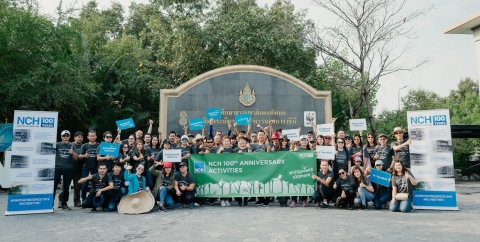 THAILAND - NCH Thailand, as part of NCH’s Global CSR initiatives in celebration of NCH 100th year anniversary and in cooperation with Foundation for Environmental Education for Sustainable Development Thailand (FEED), organized a Mangrove Reforestation activity on 19th January 2019 at Bangpu Recreation Center, Samut Prakarn Province, Thailand. This Mangrove Reforestation was a part of the event marking "the 100th Anniversary of NCH". In an honor of NCH 100th year anniversary, NCH announced that globally all employees from all 50 countries will volunteer their time to contribute to their communities and to complete more than 100 different CSR activities in total across the globe by 2019. Mr. Rod Arellano, NCH Thailand Country Manager, said "I am very glad to be a part of this Mangrove Tree planting activity, the event is very meaningful. Our associates enjoyed the fun group activities and planting mangrove seedlings for environmental sustainability.” READ MORE Highway Megaproject Tears at the Heart of New Guinea  INDONESIA - The Indonesian government is building a 2,700-mile road network on the island of New Guinea, opening up some of the world’s last great tropical rainforests to development and threatening unique indigenous cultures. Can international pressure force Indonesia to scale back this megaproject? These unique rainforests are being carved up by a massive, ill-advised, and exceptionally risky road-building scheme. The Trans-Papua Highway will sprawl like a massive spiderweb over much of the Indonesian-ruled, western half of New Guinea, known as Papua or West Papua. Totalling 2,700 miles in length, this highway network will penetrate deeply into densely forested or remote mountainous regions to increase access to minerals, fossil fuels, timber, and land for agri-business ventures, including vast palm oil plantations. Many road segments will traverse precariously steep, virgin terrain. READ MORE AMERICAS Marvellous Mangroves curriculum Suriname & French Guyana Expansion  Suriname - 2018 saw Marvellous Mangroves (MM) continue its work on the northeast coast of South America – in Suriname and French Guyana. Spring saw workshops in Coronie and Nickerie led by Mangrove Action Project’s (MAP) education director Martin Keeley. In Coronie, trainee tour guides had a refresher course on Marvellous Mangroves – covering topic areas which supplemented those of the previous fall. The workshops were also supplemented by in depth tour guide training from executives of the United Tour Guides Association of Suriname (UTGS), Errol Gezius and Yves Tjon following the same pattern given the previous fall in Commewijne and Coronie. In Nickerie the first workshop was with St. Alfonsus School and the second for tour guides, gamekeepers, executives and professionals from regional government agencies. The second workshop not only featured extensive MM activities from the water cycle to microscopic studies of micro-organisms from mangrove ecosystems, but an in-depth tour guide program conducted by Messrs. Gezius and Tjon. Following the Suriname workshops, Mr. Keeley travelled to French Guyana where he met with several local NGOs and government agencies including the Conservatoire du Littoral to lay the groundwork of bringing MM to that country. Agreements were made with several of these agencies and a MM co-ordinator for French Guyana established in the person of Lucile Dudoignon of Koté Forêt. READ MORE Insect collapse: ‘We are destroying our life support systems’ 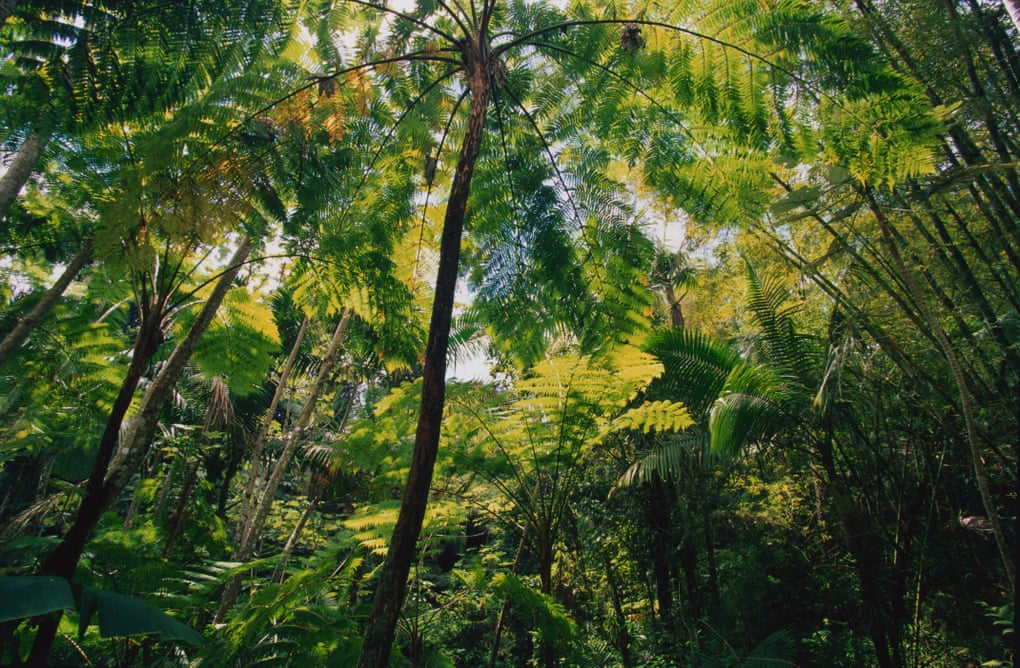 COSTA RICA - Earth’s bugs outweigh humans 17 times over and are such a fundamental foundation of the food chain that scientists say a crash in insect numbers risks “ecological Armageddon”. When Lister’s study was published in October, one expert called the findings “hyper-alarming”. The Puerto Rico work is one of just a handful of studies assessing this vital issue, but those that do exist are deeply worrying. Flying insect numbers in Germany’s natural reserves have plunged 75% in just 25 years. The virtual disappearance of birds in an Australian eucalyptus forest was blamed on a lack of insects caused by drought and heat. Lister and his colleague Andrés García also found that insect numbers in a dry forest in Mexico had fallen 80% since the 1980s. “We are essentially destroying the very life support systems that allow us to sustain our existence on the planet, along with all the other life on the planet,” Lister said. “It is just horrifying to watch us decimate the natural world like this.” READ MORE Back to Top |
ACTION ALERT
|
Mangrove Action ProjectClick here to view past newsletters |
|
Search News Archive
Thursday, January 31, 2019
MAP News Issue 461, Feb 2, 2019
Yucatan student strives to create awareness for the preservation of the mangroves of Sisal
When Alexander Imanol Chan Chuc was told that his drawing could not participate in an international competition, because it did not fit the horizontal format of the Children's International Mangrove Art Calendar 2019 calendar, he felt a great disappointment and a great sadness.
But talent knows no barriers or obstacles, so - willing to show how he imagined an ideal natural environment in his native Sisal - Chan Chuc decided to create a new drawing, absolutely different, but of equal quality, as proof that he was chosen to illustrate to the month of February.
Recently, the formal presentation of this calendar was carried out in the auditorium of the Mérida unit of the Center for Research and Advanced Studies (Cinvestav), where their respective acknowledgments were also given to both Chan Chuc and four other children whose drawings formed the images with which Yucatán participated for the first time in the contest.
Children's International Mangrove organizes a drawing contest for children and adolescents each year, from which it selects 13 images that will make up the artistic calendar, which serves to raise funds and thus support various ecological causes of the world.
This year the theme was "The importance of mangrove forests in my community" in which Yucatan participated for the first time with seven works.
A 16 year-old student of the third semester of the Tele Baccalaureate of Sisal, Alexander still can not believe that his drawing will travel the world and possibly attract the attention of someone who, like him, knows that preserving and
preserving the environment not only because it is beautiful, but necessary for the balance of
the environment.
"(I am) Excited, happy, very happy, but above all committed because it is not just a drawing. It is about creating awareness for the preservation of the mangroves of Sisal. I hope this encourages others to participate next year, but more than anything, I hope it helps to make people aware that these important spaces must be preserved
to maintain the ecological balance on the coast," said the young man.
The calendar contains images created by children from Suriname, Malaysia, Saudi Arabia, China, Nigeria, the United States, and other countries around the world.
On behalf of the local promoters of the contest, Marcela García Aguilar explained that raising awareness and sensitizing children and young people about the ecological environment, conservation and preservation of it, is betting on agents of change in the future.
The calendar costs US$15 dollars (283 Mexican pesos), plus shipping. Those interested in acquiring it can contact Cinvestav at 942-94-33.- Emanuel Rincón Becerra or visit
http://mangroveactionproject.org/childrens-calendar/
Saturday, January 19, 2019
MAP News Issue 460 Jan 19, 2019
|
The MAP News
460th Edition Jan 19, 2019 |
|
FEATURE Student named as MAPs first Junior Ambassador  AUSTRALIA - 11 year-old Anais had never realized that she would be part of saving the planet, until was selected to enter Northern Territory Education Department Sally Bruyn Senior Primary School Science Awardproject after preparing an 800 word report on Mangroves. Visiting the mangrove boardwalk and interviewing activists and indigenous locals helped Anais discover that she had a role to play in their protection. The report and video that she produced are proof that young people have a major role to play in our planet’s future. Please click the link in this story to view the video she prepared on her findings. Anais presents a strong argument for the protection and preservation of mangrove forests. MAP is extremely proud of young people like Anais, who are passionate about our planet and its protection. We applaud you, Anais, and hope that you will continue to search for solutions to today’s troubling problems. As a Thank You for your hard work, we are hereby proclaiming you to be MAPs first ever Junior Ambassador. We look forward to working with you in the future! READ MORE AFRICA Environmental education project in Grand Popo to save mangroves 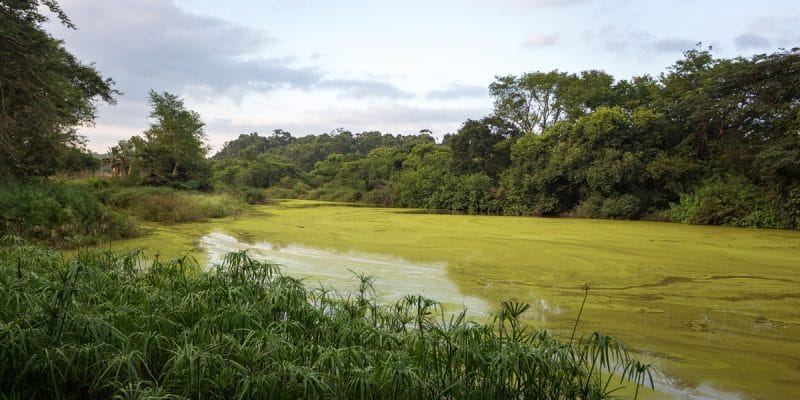 BENIN - Equilibre d’Afrique, a Beninese NGO working to preserve the environment, has just launched a new challenge. The preservation of ecosystems, particularly the mangroves located in the town of Grand Popo, in the west of Benin. On Tuesday, January 15, 2019, the association officially launched the environmental education project for communities for integrated sustainable development at the Grand-Popo Town Hall. Extended over a period of 6 months, and financed by the Swiss Cooperation’s Support Fund for Admissibility Initiatives (FoSIR 2018) for 10,366 euros, or 6,800,000 CFA francs, the project will promote environmentally friendly practices among 3528 people. This includes training and raising awareness among nearly 500 market gardeners about the dangers of chemical fertilisers. “The particularity of the cities of Grand-Popo and Agoué is that market gardening is nowadays carried out between dwellings where no space is spared. This situation exposes populations to the dangers associated with synthetic chemical inputs. In response to these problems, there is an urgent need to find sustainable solutions,” said Anani Hlondji, Mayor of Grand-Popo.READ MORE ASIA Three eco-rich sites declared environmentally protected areas Editor's note: See Last Word below for comments 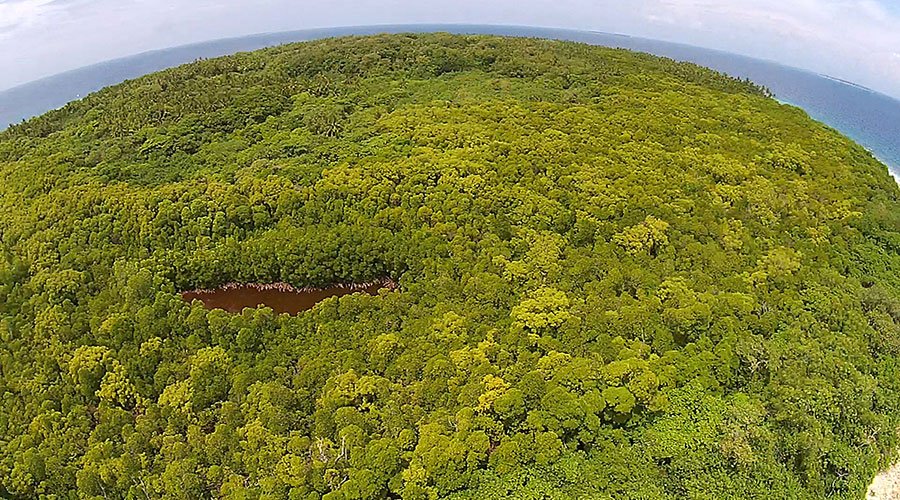 MALDIVES - President Ibrahim Mohamed Solih has decided to declare three eco-rich sites in the northernmost atolls as environmentally protected conservation areas. The sites include the island of Keylakunu in Haa Dhaal atoll, along with its reef and lagoon, and the wetlands and mangroves of the islands of Neykurendhoo and Baarah in Haa Alif atoll. The decision was made following discussions on a paper presented by the environment ministry at Tuesday’s cabinet meeting. The three sites will be protected under the Environment Protection and Preservation Act. “Prior to the Cabinet meeting, a Cabinet working session was held where presentations were delivered on the issue by environment experts,” according to the president’s office. “Members were briefed on the unique and rich eco-systems at the sites, and the urgency to conserve the areas.” Protecting at least one island, one reef, and one wetland from each atoll is part of a first 100-day action plan of the new administration. READ MORE Swimming camels, mangrove islands of Kutch face mounting challenges  INDIA - In the land of contrasts that Kutch is, winter is the lean feeding season for its unique breed of Kharai camels. These camels, unlike the kind most of us are familiar with, are typically dependent on the mangroves for food, and during monsoons, they swim to the mangrove islands in hordes and stay there for days altogether. The sight of swimming camels, as one can imagine, is spectacular, but faced with challenges such as rapid industrialisation in the coastal areas, and mangrove destruction, their population is dwindling, making it a threatened breed. The story of how the Kharai camels came into being in Kutch draws fascinating tales of folklore and belief. It is said that about 400 years ago, there was a dispute between two brothers in a Rabari family over the lone camel that they possessed. To resolve the issue, they went to Sawla Peer, a holy man, who made a wax camel near the real one and asked each to choose one. The elder brother chose the real camel; to the younger one, Sawla Peer advised to immerse the wax statue in the sea. Thousands of camels then emerged from the sea and started following him. These were the Kharai camels, and the Rabari and Jat community – the two tribes which own and handle these camels – revere it. Some also say that these camels were handed over to these tribes by the erstwhile royalty. READ MORE AMERICAS A Time To Krill ECUADOR - In Ecuador, home to the tallest mangrove trees in the world (forty meters), Dr. Stuart Hamilton of Salisbury University studies the ecological and sociological impacts of mangrove decline. His work emphasizes the impact of shrimp aquaculture, an industry that has exploded in Ecuador over the last forty years. After clearing mangrove forests, farmers cultivate shrimp in large pits dug into the sediment. The pits are crowded and subject to disease, so the farmers infuse them with antibiotics and pesticides. When they become too toxic and diseased to be viable, farmers clear more mangroves and dig more pits, leaving thousands of acres of abandoned, toxic shrimp pits behind them. Ecuador is the second-largest supplier of shrimp to the United States. READ MORE Unstoppable damage to the mangrove systems in Yucatan, new ecocide in Ría Lagartos 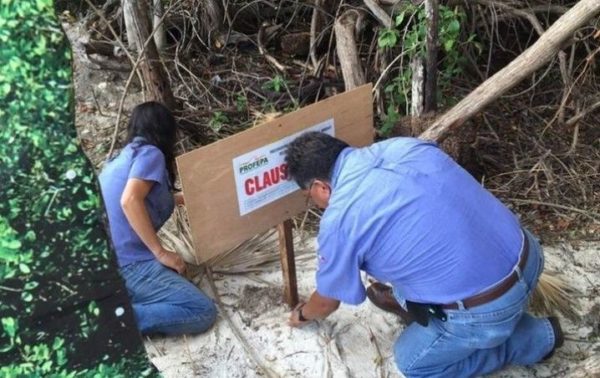 MEXICO - In an area of 2, 500 square meters, within the Natural Protected Area (ANP) Ría Lagartos Biosphere Reserve, in the Municipality of San Felipe, Yucatan, closure seals were placed on a lot, due to environmental damage and affectation of wetlands. Inspectors of the Federal Attorney’s Office for Environmental Protection (Profepa) in the state, in collaboration with the Federal Police and elements of the Ministry of the Navy, during an inspection and surveillance operation, located two affectated areas of 500 and 2,000 m2 respectively, with vegetation characteristic of the wetland ecosystem. In these properties, the inspectors detected cutting and felling of species listed in the official Mexican norm, NOM-059-Semarnat-2010, such as: red mangrove (Rhizophora mangle), white mangrove (Laguncularia racemosa), black mangrove (Avicennia germinans) and botoncillo mangrove (Conocarpus erectus), causing the fragmentation of this habitat. READ MORE Black mangroves' impact on the salt marsh food web  USA - Warmer temperatures are causing more tropical species to move northward. Among these are black mangroves, whose abundance is steadily increasing in the northern Gulf of Mexico. Black mangroves grow as short trees in a dwarf forest and displace many plants common to Gulf salt marshes. An article published this month, Tropicalization of the barrier islands of the northern Gulf of Mexico: A comparison of herbivory and decomposition rates between smooth cordgrass (Spartina alterniflora) and black mangrove (Avicennia germinans), examines how this tropical species is impacting the salt marsh food web. In this study, researchers with the Dauphin Island Sea Lab, University of South Alabama, and the Mississippi-Alabama Sea Grant Consortium teamed up to determine the black mangroves ability to shift both grazing and decomposer trophic pathways. READ MORE Mangrove forests can help fight the effects of climate change - but they are in danger  EL SALVADOR - In many tropical areas, dense mangrove forests line the shore. The trees’ tangled, exposed roots withstand the ebb and flow of daily tides.By slowing the movement of water and trapping sediment, mangroves help stabilize coastlines and reduce the impacts of storm waves and flooding – growing threats as the climate changes. These distinctive trees also help reduce global warming because their rich, waterlogged soil can absorb and store a great deal of carbon. But many mangrove forests are disappearing. “Throughout the world they’re absolutely endangered through development, through industrial agriculture, through other sorts of human activities like illegal logging.” That’s Karolo Aparicio of the nonprofit Ecoviva. The group is part of a coalition working to restore mangrove forests in El Salvador. READ MORE Residents Association Reports Destruction of Mangrove, Harm to Turtles and Illegal Construction on Santa Cruz Beach 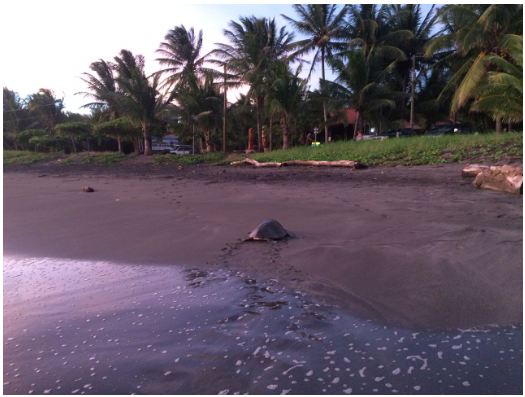 GUATEMALA - A group of Marbella residents and members of the Marbella Verde association reported to Santa Cruz City Hall the deforestation of a mangrove near the Playa del Coco estuary. Residents also reported nesting difficulties that turtles face due to lights that disorient them, which, according to the residents, comes from a restaurant. Another of their complaints is that the restaurant and other buildings may have been illegally built in the maritime zone (ZMT). In August 2018, city geologist Geissel Gutiérrez confirmed that trees had been cut down during a field visit. Gutiérrez found that logs and pieces of trees in the mouth of the one of the gutters that leads to the beach. She recommended that the mayor get in touch with the Ministry of Environment (MINAE) to report the damage to the mangrove. The Voice of Guanacaste tried to get in touch with the mayor, but she didn’t respond to calls and messages sent to her cell phone by the time this newspaper went to print. Minae still doesn’t have a report of the damage to the mangrove since residents have not yet filled one. READ MORE EUROPE Small mangrove patches 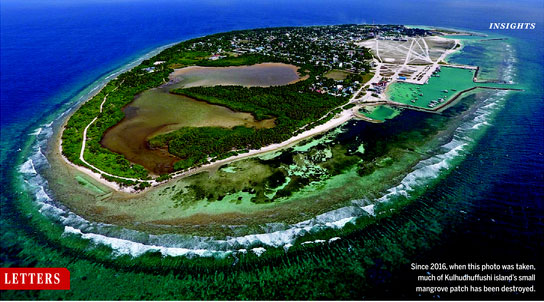 U.K. - The loss of relatively small patches of mangrove may seem less concerning than large-scale deforestation. However, these patches are especially important to low-lying island nations vulnerable to climate change and sea-level rise. Their interconnectedness with adjacent habitats, such as coral reefs, allows them to provide substantial ecosystem services relative to their size. The continued loss of mangrove patches further fragments mangrove habitat, which creates barriers to species movement and dispersal. The loss also drastically erodes local coastal resilience and pushes key mangrove ecosystems toward collapse. Given the recent Intergovernmental Panel on Climate Change’s projections, we simply cannot afford to lose more mangrove forests, irrespective of their size. We call on governments to move away from policy decisions that prioritize large areas and short-term local political gains and instead adopt a more holistic long-term vision, whereby the value of smaller mangrove patches is better appreciated and safeguarded. READ MORE Global Mapping the world's 'blue carbon' hot spots in coastal mangrove forests 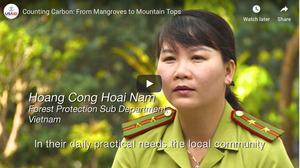 GLOBAL - Human actions have boosted carbon dioxide concentrations in the atmosphere to levels higher than any measured over the last 160,000 years. Rising concern over the risk of severe impacts from climate change is spurring research into ways in which ecosystems may mitigate global warming by storing excess carbon in plants and soil.Our research group has studied the ecology of mangroves for over 40 years.In a recent study, we have shown that previous studies have overestimated blue carbon storage in some river delta areas, such as the Amazon in Brazil; the Sundarbans region in India, where the Ganges, Brahmaputra and Meghna rivers converge; the Zambezi delta in Mozambique; and the Indus river delta in Pakistan. Others have grossly underestimated blue carbon storage in carbonate (peat-dominated) coastlines, such as Belize, the Florida Keys, Puerto Rico, Mexico's Yucatan, Cuba, the Dominican Republic and several Caribbean islands.The key to improving these estimates, we found, is to factor in how rivers, tides, waves and climate shape coastal landforms to create different environmental settings. Using this approach, we have produced a more accurate estimate of global blue carbon "hot spots" – an important first step toward protecting them. READ MORE LAST WORD We at MAP are convinced that a major effort must be made globally to conserve remaining primary mangrove forests, and the loss of such primary forests has terrible repercussions for our planet's health and cannot be effectively addressed by any remedial efforts to restore mangroves. Even MAP's Community-based Ecological Mangrove Restoration (CBEMR) best practices approach can never re-establish the full biodiversity of a destroyed mangrove ecosystem, which consists of far more than the mangrove trees and their associate plant species. The mangrove ecosystem includes all the life forms that it encompasses, including the marine life, insects, mammals, reptiles and migratory birds. As well the vital functions and services that healthy mangroves provide are significantly weakened by such loo of primary mangroves as we are sadly witnessing now in the Maldives. With this in mind, we at MAP are working with others from the Mangrove Specialist Group to halt further destruction of the primary mangrove forests of the Maldives. We are co-signers on a recently published letter in Science that addresses these issues. Also, I am submitting a letter to the president of the Maldives regarding the urgent need to protect the remaining mangroves of the Maldives island chain from further ruin, Please write your own letters if you can, as the more of us submitting letters will better the prospects for a positive change in government development policy. This is the time to act now to save the remaining primary mangrove forests before none remain! For the Mangroves and Mangrove Communities, Alfredo Quarto, Co founder, Mangrove Action Project Back to Top |
ACTION ALERT Save Pulau Kukup National Park - second largest mangrove island in the world. Sign The Petition Video: Mangroves for the Future - A look bacK. As the latest phase of Mangroves for the Future (MFF) draws to a close, this video highlights some of the project’s most successful initiatives – from local women supporting national park management in Viet Nam to an island in the Maldives that has become a model for waste management, and everything in between. View Here Making the case for Emergency Climate Change Action
|
Mangrove Action ProjectClick here to view past newsletters |
|
Subscribe to:
Posts (Atom)
-
The community of adults and youth in Cayman Islands has come together recently to release a series of educational videos. Each is geared to...
-
By Alfredo Quarto, Program & Policy Director Co-founder, MAP There is a rather urgent situation concerning the bio-invasion of the Son...
-
By: Isabel Robinson, MAP Volunteer Intern Some months ago I decided to come to Thailand and do an internship in mangrove conservation, ...
MAP News Issue #596 = April 20, 2024
ENTRIES NOW OPEN! Mangrove Photography Awards 2024 10 Years Celebrating Mangroves GLOBAL - MAP has launched our 10th Mangrove Photograp...

















